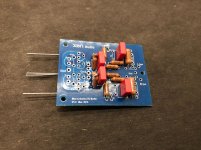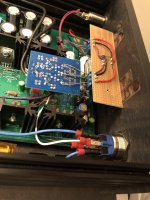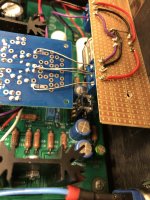May i ask, i want to use whammy for pre with the F5v3. The only change is R4 and R8 from value 4,7k to 10k?
For input (from whammy) can i use Mezmerize B1 Buffer ( unity gain) ? (6inputs)
Thank you in advance !
For input (from whammy) can i use Mezmerize B1 Buffer ( unity gain) ? (6inputs)
Thank you in advance !
Replacement for 7815 and 7915 regs
Hi,
I'm about to order the kit from the store.
A friend of mine came to my place and we listen through a F5T on Dynaudio's Confidence 30, simply amazing.
My preamp is a Threshold (modified, with Mundorf coupling and filter caps) Fet One series Two.
The Whammy is not as "beautiful" but has more warmth in the low midrange, and better image. So I'll make some trials by modding it.
The Threshold has a lot of buttons where the signal goes through, this might be the reason where the Whammy performs better.
I would like toi replace the standard 7815 and 7915 with something better, and I found this: DEXA DX7815 15.0V UWB Regulator +15V - Audiophonics
and this: DEXA DX7915 -15.0V UWB Regulator -15V - Audiophonics.
It says 630mA for both the positive and negative regulator.
A standard 7815 or 7915 can deliver 1,5 A, but how much does the Whammy drag as current for the 15 Volts?
Thanks for your help,
- dan
Hi,
I'm about to order the kit from the store.
A friend of mine came to my place and we listen through a F5T on Dynaudio's Confidence 30, simply amazing.
My preamp is a Threshold (modified, with Mundorf coupling and filter caps) Fet One series Two.
The Whammy is not as "beautiful" but has more warmth in the low midrange, and better image. So I'll make some trials by modding it.
The Threshold has a lot of buttons where the signal goes through, this might be the reason where the Whammy performs better.
I would like toi replace the standard 7815 and 7915 with something better, and I found this: DEXA DX7815 15.0V UWB Regulator +15V - Audiophonics
and this: DEXA DX7915 -15.0V UWB Regulator -15V - Audiophonics.
It says 630mA for both the positive and negative regulator.
A standard 7815 or 7915 can deliver 1,5 A, but how much does the Whammy drag as current for the 15 Volts?
Thanks for your help,
- dan
My LM4562NA arrived today and just finished swapping it in. Immediately heard a difference over the OPA2134 I had in there. I can now crank it all the way up through 100k of resistance(unrealistic test), and not hear the slightest bit of noise. Amazing. The OPA2134 might be more 'musical' for some people, but I actually find the LM4562 to be more sterile, having more detail in the high end.
The only (real) opamp I have hated in mine so far was the TL082(weird midrange distortion unique to this amp).
The only (real) opamp I have hated in mine so far was the TL082(weird midrange distortion unique to this amp).
Last edited:
........have a look at post 1 in this thread......the schematic shows the currents ......
Hi,
Maybe I'm dumb but I checked all the schematics but couldn't find any current drag indications...
Point me, please!
- dan
Output source resistors determine most of the current. 10 Ohms = 60 mA channel, 15 Ohms = 40 mA channel, 22 Ohms = 27 mA channel.
I want to use whammy for pre with the F5v3. The only change is R4 and R8 from value 4,7k to 10k?
Correct, no changes needed.
Looking at post #999 and it’s associated messages, that user wanted a particular knob position for a given volume, instead of just turning the knob more. There’s no real reason to increase the gain.
Looking at post #999 and it’s associated messages, that user wanted a particular knob position for a given volume, instead of just turning the knob more. There’s no real reason to increase the gain.
I had the pleasure to do some listening tests with Patrick’s discrete opamp design as a beta tester.
I used my Whammy build for the testing and tuned it a bit according to Patrick’s advices. The gain was set to 10x to compensate the Xen passive Xfeed and it’s attenuation. With the Xfeed installed gain is 3x. See the attached pics of Xfeed board (quick and dirty temporary installation) and discrete opamp in place.
The listening test was done between OPA2131, OPA627 and the Xen discrete. The source was RPi with Ian Canada’s ESS9038 dual DAC, FiFoPi, and opamp IV board, feeded with Ian’s battery board. You can check my DAC build here. Headphones were Audeze LCD-2f and music files ripped CDs in FLAC format played with Moode Audio player.
The discrete one was better with especially female vocals. Xen discrete opamp seemed to be also more fluent and easier to listen to. Then the OPA627 was a tiny bit better with male vocals, maybe due to the fact that it sounded a little warmer in mid region. As in comparison to OPA2132 I found no differences with bass depth/fastness or with high frequencies. Both the discrete and OPA627 were better than the OPA2132.
The differences were small and the back-to-back comparison is difficult since you obviously have to switch the systems off to change the opamp. But all in all, I can surely recommend the Xen discrete opamp with Whammy.
I used my Whammy build for the testing and tuned it a bit according to Patrick’s advices. The gain was set to 10x to compensate the Xen passive Xfeed and it’s attenuation. With the Xfeed installed gain is 3x. See the attached pics of Xfeed board (quick and dirty temporary installation) and discrete opamp in place.
The listening test was done between OPA2131, OPA627 and the Xen discrete. The source was RPi with Ian Canada’s ESS9038 dual DAC, FiFoPi, and opamp IV board, feeded with Ian’s battery board. You can check my DAC build here. Headphones were Audeze LCD-2f and music files ripped CDs in FLAC format played with Moode Audio player.
The discrete one was better with especially female vocals. Xen discrete opamp seemed to be also more fluent and easier to listen to. Then the OPA627 was a tiny bit better with male vocals, maybe due to the fact that it sounded a little warmer in mid region. As in comparison to OPA2132 I found no differences with bass depth/fastness or with high frequencies. Both the discrete and OPA627 were better than the OPA2132.
The differences were small and the back-to-back comparison is difficult since you obviously have to switch the systems off to change the opamp. But all in all, I can surely recommend the Xen discrete opamp with Whammy.
Attachments
Last edited:
Glad you like it.
It is your turn to build your own. 😉
There are two more different topologies to come.
I shall open a new thread at the "Analogue Line Level" forum and publish circuit details later.
Patrick
It is your turn to build your own. 😉
There are two more different topologies to come.
I shall open a new thread at the "Analogue Line Level" forum and publish circuit details later.
Patrick
As promised :
https://www.diyaudio.com/forums/ana...iscrete-opamp-dip8-footprint.html#post5780757
Patrick
https://www.diyaudio.com/forums/ana...iscrete-opamp-dip8-footprint.html#post5780757
Patrick
Trickle Down, Up or Sideways ?
June 2019's Stereophile Magazine carries a review of the $9,500 Pass Labs XP-22 preamp. The designer is none other than Wayne Colburg who designed the Whammy and who is quoted in the review : 'We use an optically isolated transistor in the output bias circuit for a couple reasons...the first being that the transistor is isolated from any input control signal, so there are no artifacts from such a connection, and also because the LED which controls the transistor has a constant voltage characteristic which is also free of thermal drift.' Does this sound familiar to Whammy builders ?
I wonder if Wayne would be able to share which came first : the Whammy or the XP-22, or if they were developed in parallel, and if there are any other bits of shared technology.
June 2019's Stereophile Magazine carries a review of the $9,500 Pass Labs XP-22 preamp. The designer is none other than Wayne Colburg who designed the Whammy and who is quoted in the review : 'We use an optically isolated transistor in the output bias circuit for a couple reasons...the first being that the transistor is isolated from any input control signal, so there are no artifacts from such a connection, and also because the LED which controls the transistor has a constant voltage characteristic which is also free of thermal drift.' Does this sound familiar to Whammy builders ?
I wonder if Wayne would be able to share which came first : the Whammy or the XP-22, or if they were developed in parallel, and if there are any other bits of shared technology.
MIthrandir patented Optical bias eons ago
and be sure he (they) invented several topology variations after that
and be sure he (they) invented several topology variations after that
- Home
- Amplifiers
- Pass Labs
- "WHAMMY" Pass DIY headphone amp guide



